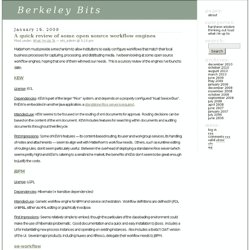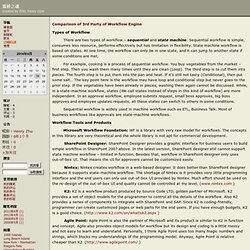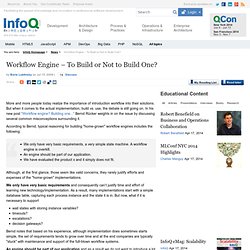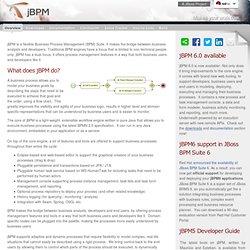

A quick review of some open source workflow engines « Berkeley Bits. Matterhorn must provide a mechanism to allow institutions to easily configure workflows that match their local business processes for capturing, processing, and distributing media.

I’ve been looking at some open source workflow engines, hoping that one of them will meet our needs. This is a cursory review of the engines I’ve found to date: License : ECL Dependencies : KEW is part of the larger “Rice” system, and depends on a properly configured “Kuali Service Bus”. If KEW is embedded in another Java application, a standalone Rice server is required . Intended use : KEW seems to be focused on the routing of xml documents for approval. First impressions : Some of KEW’s features — its content-based routing, its user and workgroup services, its handling of notes and attachments — seem to align well with Matterhorn’s workflow needs. jBPM License : LGPL Dependencies : Hibernate (+ transitive dependencies) Intended use : Generic workflow engine for BPM and service orchestration.
Os-workflow Intalio. Comparison of BPEL engines. Comparison of 3rd Party of Workflow Engine - Henry Zhu. Types of Workflow There are two types of workflow – sequential and state machine.

Sequential workflow is simple, consumes less resource, performs effectively but has limitation in flexibility. State machine workflow is based on states. At one time, the workflow can only be in one state, and it can jump to another state if some conditions are met. For example, cooking is a process of sequential workflow. Sequential workflow is widely used in machine workflow such as ETL, Business Talk. Workflow Tools and Products Microsoft Workflow Foundation: WF is a library with very raw model for workflows.
SharePoint Designer: SharePoint Designer provides a graphic interface for business users to build simple workflow in SharePoint 2007 above. Nintex: Nintex creates workflow in a web-based designer. K2: K2 is a workflow product produced by Source Code LTD, golden partner of Microsoft. Agile Point: Agile Point is also the partner of Microsoft and its product is similar to K2 in function and concept. Workflow Engine – To Build or Not to Build One? More and more people today realize the importance of introduction workflow into their solutions.

But when it comes to the actual implementation, build vs. use, the debate is still going on. In his new post "Workflow engine? Building one... " Bernd Rücker weights in on the issue by discussing several common misconceptions surrounding it. According to Bernd, typical reasoning for building "home-grown" workflow engines includes the following: We only have very basic requirements, a very simple state machine. Although, at the first glance, those seem like valid concerns, they rarely justify efforts and expenses of the "home-grown" implementations. We only have very basic requirements and consequently can’t justify time and effort of learning new technology/implementation.
Wait states with storing instance variables? Bernd’s suggestion for such scenarios is to consider a lightweight Java workflow engine, which can be easily included into your product. Please, do not develop! jBPM. jBPM is a flexible Business Process Management (BPM) Suite.

It makes the bridge between business analysts and developers. Traditional BPM engines have a focus that is limited to non-technical people only. jBPM has a dual focus: it offers process management features in a way that both business users and developers like it. What does jBPM do? A business process allows you to model your business goals by describing the steps that need to be executed to achieve that goal and the order, using a flow chart. This greatly improves the visibility and agility of your business logic, results in higher-level and domain-specific representations that can be understood by business users and is easier to monitor.
The core of jBPM is a light-weight, extensible workflow engine written in pure Java that allows you to execute business processes using the latest BPMN 2.0 specification. jBPM is also not just an isolated process engine. Process languages jBPM6 What to do if I encounter problems or have questions?